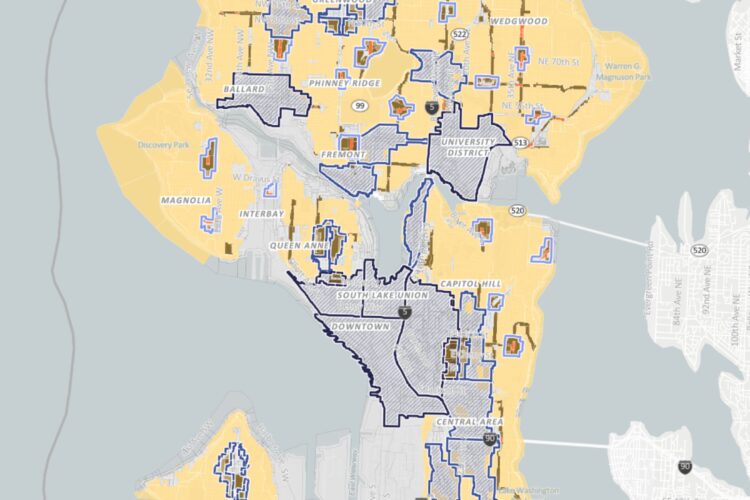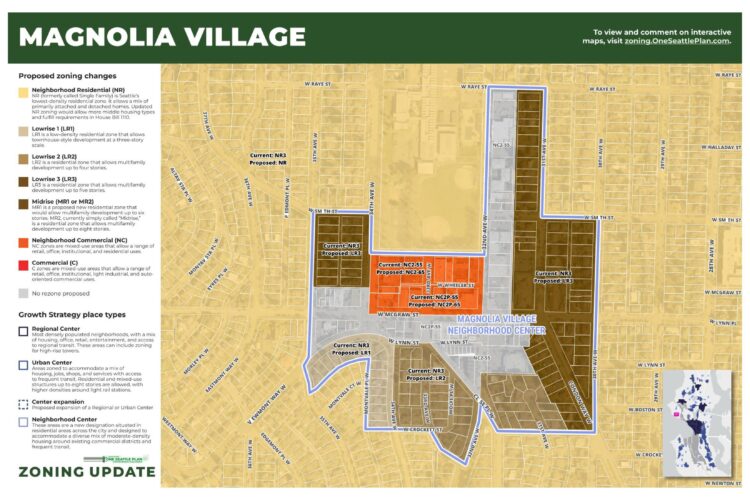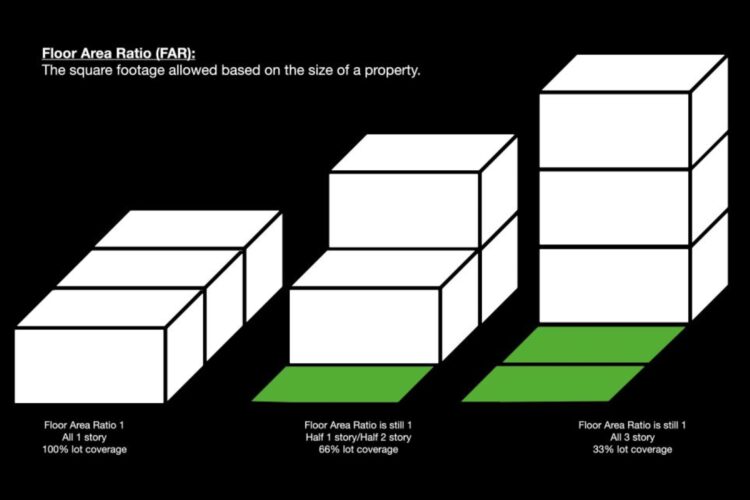Seattle ADU and Zoning Updates: What Homeowners Need to Know
October 30, 2025
Once again, Seattle’s approach to accessory dwelling units (ADUs) and single-family zoning has undergone a major transformation. With the adoption of Council Bill 120969, the City of Seattle is taking a bold step toward a more inclusive and adaptable city landscape. As of October 2025, Seattle’s Neighborhood Residential (NR) zones (formerly single-family zones) will now allow up to four separate homes on one lot, moving beyond the old restrictions of one main house plus ADUs. In some cases, even more units are possible on larger lots if certain parameters are met. Let’s break down these Seattle ADU and zoning changes below!
For decades, the residential zoning in the city was anchored in the principle of one primary dwelling per lot, with the possibility of a single, often smaller, accessory dwelling unit (ADU) or detached accessory dwelling unit (DADU). The recent zoning reform ordinance overhauled how many homes can be built on a lot in Neighborhood Residential zones. Under the new 2025 law, the distinction between a “primary” dwelling and “accessory” units is largely erased.
This regulatory shift in Seattle is a direct consequence of new mandates from the Washington State Legislature, primarily through House Bill 1110 and House Bill 1337 which, respectively, allow a wider variety of housing types in areas traditionally designated for single-family homes and addresses barriers to building ADUs, eliminating the long-standing requirement for owner-occupancy. Seattle has embraced the maximum flexibility allowed – even the affordability bonus concept – to stay ahead of state mandates.
Key Changes for Seattle ADUs/Zoning
Up To Four Units Per Lot – Every NR Lot (this would be most single-family homes) in Seattle can have up to four units (attached or detached) This effectively means one lot could host four small houses, two duplex buildings, or really any combination totaling four dwellings. The units can also be configured in any form – detached cottages (like multiple DADUs), attached townhouses, or stacked apartments such as a fourplex, as long as building code and site-requirements (height, setbacks, etc.) are met. In other words, Seattle homeowners are no longer restricted to just one backyard cottage.
Potential For More Units On Larger Lots – Seattle code includes an optional density provision roughly equivalent to one unit per 1,250 sq ft of lot area. If a homeowner participates in the Mandatory Housing Affordability (MHA) program and owns a lot larger than 5,000 square feet, they could have a green light to build more than four homes on their property. Under the same circumstances, an 8,000 square foot lot may be allowed up to six dwellings and a 16,000 sq ft lot up to 12 units. More on this below.
MHA Requirements – Because this new zoning change increases housing capacity in historically single-family zones, it triggers Seattle’s Mandatory Housing Affordability (MHA) program. This means projects that add extra units must either include an affordable housing unit on-site or pay an in-lieu fee to the city’s affordable housing fund in an effort to ensure new developments contribute to housing affordability citywide. The MHA contribution is required regardless of how the number of additional units are built, although smaller projects often pay a relatively modest fee. On the opposite end of the spectrum, homeowners embarking on larger projects, with more units, can expect to pay a higher fee.
No Owner-Occupancy Requirement – The City of Seattle had already removed the owner-occupancy rule for ADUs in 2019, and the new rules continue to allow non-owner occupied investment or rental properties with multiple units.
Removal of Seattle ADU/DADU Size Limits – In the past, a DADU in Seattle was limited to 1,000 square feet. Now unit size is constrained mostly by the overall Floor Area Ratio (FAR) and lot coverage limits, rather than a strict square-foot cap per unit.
FAR is simply the square footage of a structure divided by the square footage of the lot it’s built on.
Parking – Off-street parking is still not required for additional units, similar to the 2019 ADU reforms. Homeowners can choose whether to include parking based on their needs, but the code does not force it. This is an effort to encourage transit use and reduce construction costs.
To reflect these law changes, the Seattle Department of Construction & Inspections (SDCI) updated the Seattle Municipal Code (Title 23) – the term NR “Neighborhood Residential” replaced SF “Single Family” in the code, and many sections regarding ADUs have been revised to categorize all dwelling units more equally. The new code will now emphasize overall site and design standards including things like height, yards, green space, lot coverage, and FAR to manage building bulk and neighborhood fit, rather than on whether a unit qualifies as an “accessory” or not.
Comparison
To further explain these changes, below is a comparison of Seattle’s old DADU/ADU rules side by side with the new 2025 four-homes-per-lot rules:
| Old Rules (pre-2025) | New Rules (2025) | |
| # Of Units | 3 Total – 1 single-family “primary” home + 1 ADU + 1 DADU | Up to 4 dwellings on any NR lot. No “primary v accessory” distinction. Units Allowed (Bonus): Large lots can exceed 4 units with MHA fee. This allows about 1 unit per 1,250 sq. ft. of lot area with a contribution to Seattle affordable housing. For example, ~5 units on a 6,250 sf lot, 6 units on 7,500–8,000 sf, and up to 12 units on a 15,000 sf lot (capped by the formula). |
| Usage | ADUs could not be sold separately; they could be rentals or used for family only, tied to the main property and owner occupancy. | All units are regular dwelling units; an owner can live in one and rent the others, rent all four, or potentially sell them as separate condos. |
| Size Limits | Detached ADUs must remain under typically max 1,000 sq. ft. (with some exceptions), attached ADU often limited by a percentage of the main house size. | No explicit unit size cap. Instead, Floor Area Ratio (FAR) limits how much total building floor area can be developed. Eg, a FAR of ~0.7 on a 5,000 sf lot means up to ~3,500 sf of total floor space (could be one big house or split among four smaller homes). The FAR caps ensure multiple units’ design toward moderate-size homes. |
| Lot Requirements | Implicitly, one “primary” unit had to exist before adding ADUs. Minimum lot size for a DADU was 3,200 sq. ft. in many zones. | No minimum lot size to build multiple units (in Seattle code can be as low as 2,500 sq. ft. for smaller lot). Even lots under 3,200 sq. ft. (prev. DADU cutoff) can now have duplexes or more, as long as they fit within coverage/FAR limits. |
| Owner Occupancy | No owner occupancy required after 2019 (Seattle removed this requirement to encourage ADU development). | Still not required. You can rent out all units or any combination thereof. |
| Parking Requirement | No off-street parking required for ADUs (parking mandate was dropped in 2019 reforms). | No off-street parking required by code for added units, aligning with Seattle’s transit-first and climate goals. |
| Lot Coverage & Yards | 35% lot coverage limit for structures (with slightly higher allowance on small lots) and standard setback requirements, which constrained how large and where ADUs could be built in a backyard. | The same lot coverage limits apply, but now to all structures collectively. Max coverage is 35% for the portion of lot covered by roofed structures (slightly higher for smaller lots). Standard setbacks (typically 5 ft from side lot lines, 25 ft from) still apply. |
| Height | DADUs had their own height limits depending on lot width (generally 16–23 feet max to the roof peak, varying by lot width and roof type). | Height limits remain (typically 30 ft for the principal structure in NR zones), and detached backyard cottages have slightly lower height caps if near lot lines (16-20 ft depending on roof style). If multiple “primary” buildings exist, one might be treated as the main and others as DADUs for height restrictions. |
| MHA Fees | No fees were required. | Any project adding more than one unit will incur an MHA fee or require an affordable unit. Sliding scale fee based on ADU/DADU sq footage. |
| Resale/Splitting | Sale of units was not allowed. | You can sell units individually if a Unit Lot Subdivision or Condo Plat. |
Key Takeaways
In short, Seattle’s 2025 zoning changes open a new chapter for homeowners. The familiar terms “ADU” and “DADU” may soon fade as we move toward a more flexible model that treats all small homes equally. What remains constant is the opportunity for homeowners to shape their property in creative, practical ways — from building a rental cottage to adding a home for multi-generational living.
At Harjo Construction, we’re here to help you make sense of the new rules, explore what’s possible on your lot, and guide you from concept to construction with confidence.



